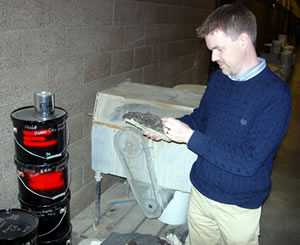By Nick Carpenter

Mats Wendel, national coordinator of pavements for the Swedish Road Administration, has been in Minnesota since last August sharing information about various transportation-related issues with Mn/DOT. Photo by Michaela Wendel |
For more than 10 years, Mn/DOT has taken part in international exchange agreements with various European countries, particularly the Nordic nations.
The idea for an exchange program originated from the Mn/DOT maintenance staff’s interest in comparing their practices with those of Scandinavia, which boasts a climate similar to Minnesota. The program has resulted in several professional exchanges with Finland, Sweden and Norway during this past decade.
Last spring, Mn/DOT invited Mats Wendel, national coordinator of pavements for the Swedish Road Administration, to exchange information about various transportation-related issues with the department. Wendel also brought his wife and three children along to “experience life in Minnesota.”
While there have been numerous exchanges in the past, none of them have been as long as Wendel’s, who arrived last August and will return home this fall.
“His stay is longer so that we can truly learn from each other on a variety of subjects including pavement materials, design, maintenance and construction and contracting methods,” said Maureen Jensen, Mn/DOT road research manager.
Wendel specializes in working with road materials and has done so for more than 20 years. During his time in Minnesota , Wendel has shared his experiences through presentations given to a variety of audiences, including researchers at the University of Minnesota, the Transportation Engineering and Road Research Alliance Board and colleagues within the department.
What innovations do you see in Sweden that could work in Minnesota?
Well, a greater use of thin asphalt layers such as Novachip would be one of them. Another would be the flow-mixing method, where the raw materials are mixed in a controlled sequence, which results in a more homogenous mix with better performance. Certain contracting applications to encourage the use of innovations could also be beneficial.
I think in some ways contractors have it easier here in Minnesota, which can lead to certain risks. In Sweden, we are more innovative with our contracting and I believe it allows us to conduct business more efficiently. SRA requires a five-year warranty on our construction projects, so the contractor is responsible for delivering a quality product. The warranty gives the contractor an incentive to perform good workmanship.
However, Mn/DOT performs a more thorough investigation of the materials before they go into the road. SRA relies on the warranty and the contractor to come up with the road materials, which still must meet SRA specifications.
What are some of the biggest differences regarding roads in Minnesota and Sweden?
There are a few key differences between roads in Sweden and roads in Minnesota. We don’t have a problem with extreme low-temperature cracking on our roads in Sweden. Even though we have similar temperatures, we do not experience the rapidly changing seasons accustomed to Minnesota. Our roads deteriorate mainly due to the use of metal-studded tires, aging and, in some cases, deformation.
Also, we use one-forth the amount of road salt that Minnesota uses due to environmental concerns. When the snow and ice melt in Sweden, the roads are black, while the roads here turn white. Our roads are not as clear during the winter months, but the tire paths are clear enough for travel, which substitutes for our lack of a clear-roads policy.
Another big difference is the way the roads are constructed. In Sweden, we build our roads with a thicker unbonded layer and a thinner asphalt layer on top. The supply of unbonded material is great so it’s a cheap practice. Asphalt is not as cheap, so we tend to apply a thin layer. Minnesota uses a thicker layer of asphalt and thinner layer of unbonded material than we do.

Wendel said one of things he will share with his colleagues when he returns to Sweden this fall is information about MnROAD and how it is a valuable resource for data that could greatly benefit Sweden's road work. Photo by Nick Carpenter |
What are some other differences between Minnesota and Sweden relative to transportation?
Sweden is a lot more public-transportation-oriented as the cities are more connected. It boasts a highly efficient transit system complete with commuter bus and passenger rail lines.
We also have fewer concrete roads because purchasing the material is very expensive. In Sweden, we don’t strive to build the everlasting road so our design process is often set to incorporate a lifespan of 20 years.
What do you hope to take back to Sweden from your time with Mn/DOT?
One of my main goals is to come up with three to five best practices from my work here in Minnesota that we can learn from and implement back in Sweden.
Along with that, I would like to share my knowledge with Mn/DOT and hopefully they can take ideas from me and implement them here. I now have a better idea of what might work in Sweden and what will not work in Sweden.
Also, I must mention the MnROAD facility. It is one of the great cold-climate transportation resources in the world; Sweden has nothing that is comparable. When I return to Sweden from my stay here, I will let my colleagues know about MnROAD and how it can be used as a valuable resource for data that could benefit our roadwork greatly.
Do you or a co-worker have an interesting job to share with readers? Click here to send us your ideas, and we’ll contact you for more information.
Recent employee profiles:
|



